Brunk Auctions, Asheville, North Carolina
Photos courtesy Brunk Auctions
Brunk Auctions’ “Premier” sale in Asheville, North Carolina, on Saturday, September 11, was a day when, in the words of American fine art specialist Nan Zander, the history of American painting was on display. In addition, major collections of American furniture and Delft pottery were scheduled for sale. It was a two-day auction, but with so many exceptional lots, this report focuses on an exceptional Saturday.
Perhaps the most dramatic moments of the eight-hour sale occurred at lots 1111 and 1112, the first of the Delft lots from the superb collection of Constance (1929-2014) and Dudley (1926-2007) Godfrey. Since 2018 Brunk Auctions has had various components of the massive Godfrey collection in at least six sales. The renovated American art wing of the Milwaukee Art Museum was named for the couple.
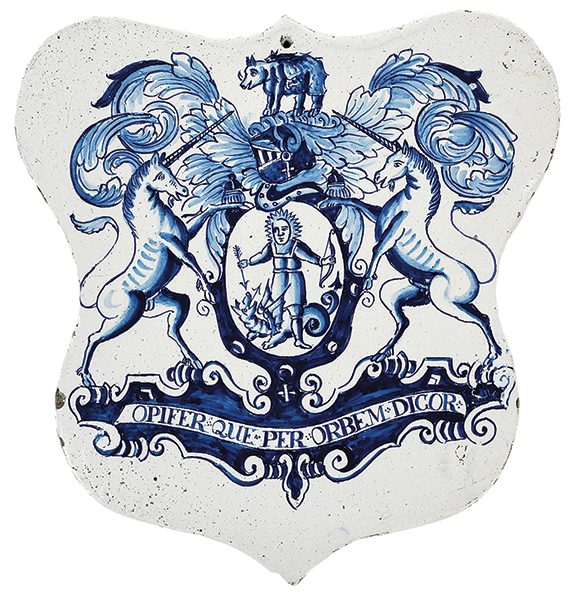
The crest on this 1720-40 Delft pill tile features Apollo, the god of healing, subduing the dragon of disease over a Latin motto translated as “Throughout the world, they speak of me as the bringer of help.” The unicorns apparently represent King James I bestowing approval on the profession. At the top of the tile is a rhinoceros, whose horn was believed to have medicinal properties. The tile, which measures 11 5/8″ x 11¼”, is pierced for hanging. It sold to a phone bidder for $49,200 (est. $12,000/15,000).
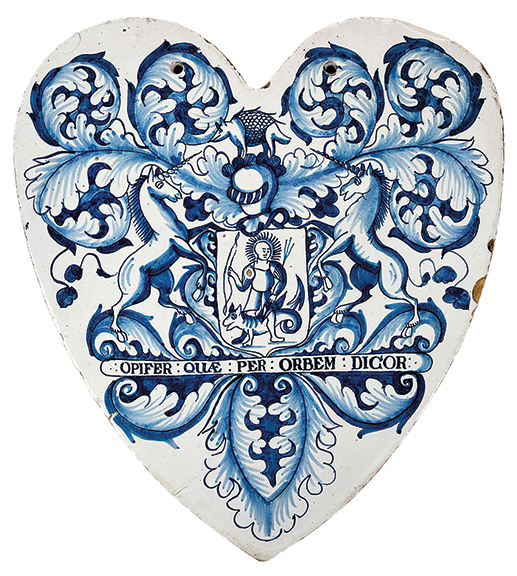
This heart-shaped Delft pill tile, inscribed with a crest similar to the Apollo pill tile, has elaborate foliate scrolls and measures 11 7/8″ x 10¾”. It sold for $51,660 (est. $12,000/15,000) to an English dealer, the same phone bidder who won the Apollo pill tile.At least five staffers on the phones managed the bidding war for lot 1111, a large 1720-40 Delft blue-and-white shield-shaped pill tile estimated at $12,000/15,000. These porcelain tiles, with the crest of the Worshipful Society of Apothecaries, were awarded to newly trained London pharmacists. Two phone bidders battled for the tile. One dropped out as Internet bidders jumped in and then returned to bid again. Phone bidder 627, an English dealer, prevailed over phone bidder 632, an American private collector, at $49,200 (including buyer’s premium).
The next lot, a large heart-shaped Delft pill tile with a similar crest, date, and estimate, provided an Anglo-American rematch. You could feel the determination in the American’s bidding as he went up against the English dealer and others on the Internet. In the face of fast-reacting opposition, the Englishman dropped out, and it looked as though the American would finally triumph. But, alas, the Englishman rejoined the bidding, and the American yielded again, this time at $51,660. Frustration and disappointment were as tangible as the tile itself.
The Delft tiles were among the sale’s high-dollar lots, but American paintings were the sale’s shining stars. Consignors included the Virginia Museum of Fine Arts, various private collections, and the estate of tech entrepreneur, author, and racecar driver Joel E. Finn (1938-2017) and his wife, Ann. Buyers included three institutions, dealers, and several new and returning private collectors.
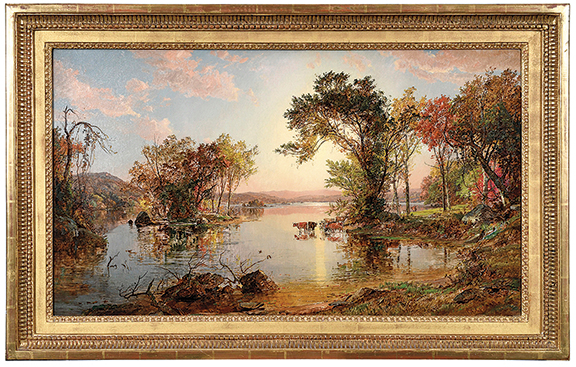
Honors for the sale’s top lot went to Autumn Landscape with Cattle, an 1879 oil on canvas by Jasper Francis Cropsey (1823-1900). The 22½” x 39″ (sight size) painting sold to a bidder on the phone for $196,800 (est. $80,000/120,000).The leader of this impressive constellation was the museum’s Autumn Landscape with Cattle, a signed and dated (1879) oil on canvas by Jasper Francis Cropsey (1823-1900). Autumn opened at $65,000, and by $85,000 the sole floor bidder was out. Absentee bidding was especially strong until $140,000, when a New York dealer on the phone prevailed and won the lot at $196,800. Bidding on the museum’s A Quiet Valley, a signed and dated (1855) landscape by Luminist Albert Bierstadt (1830-1902), appeared to be confined to the phones, where it sold to a private collector for $159,900.
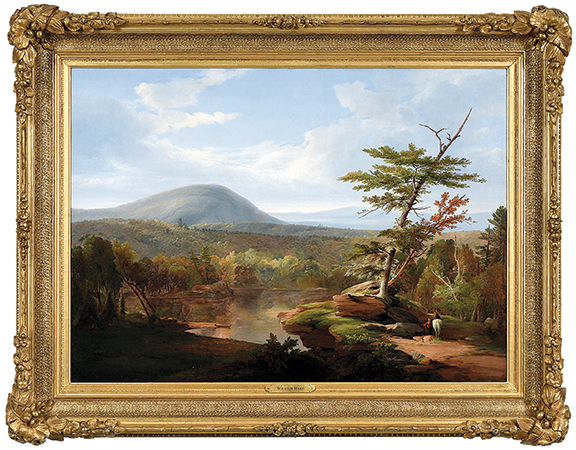
William Hart (Scottish/American, 1823-1894) painted View of the Catskills in 1849 while living in Albany, New York. Later that year, Hart, who primarily painted portraits, received financial support from a local benefactor to study landscape painting in Europe. He returned to the States in 1853. Perhaps it was this 26¼” x 36¼” (sight size) oil on canvas that convinced his benefactor to invest in the 26-year-old novice. The painting sold for $61,500 (est. $35,000/55,000).
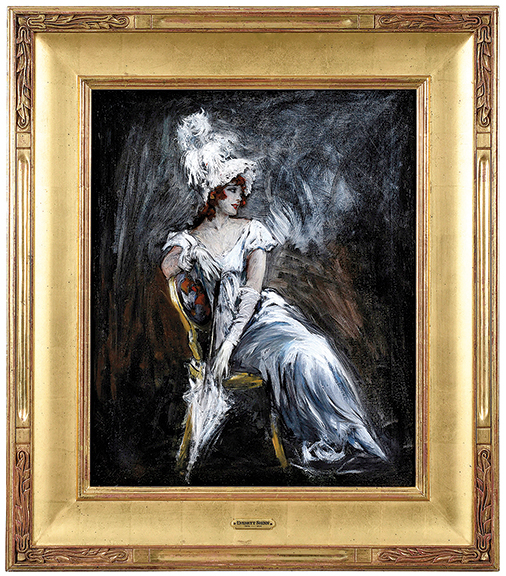
Everett Shinn (1876-1953) was enamored of the New York theater and theater people. He painted The Performer, 20″ x 24″ (sight size), circa 1910; it sold to a New York dealer on the phone for $59,040 (est. $30,000/50,000). In 1910 Shinn and two others painted 18 allegorical murals for the Belasco Theatre on West 44th Street. During its 2010 renovation, Shinn’s murals were restored.Three paintings, An Idle Moment by portraitist John White Alexander (1856-1915), View of the Catskills by Hudson River school artist William Hart (1823-1894), and The Performer by Everett Shinn (1876-1953) of the Ash Can school, took the next high-dollar spots. All three were from private collections. An Idle Moment, which had been purchased by a Florida collector at Christie’s in 1999, sold on the Brunk Auctions live Internet bidding platform to a private collector for $86,100. View of the Catskills sold to a private collector on the phone for $61,500. The Performer, which had sold at Sotheby’s New York for $48,875 in 1994, sold here for $59,040 to the same New York dealer who bought the Cropsey painting.
Dropping a notch, five paintings sold in the $30,000 to $60,000 range:
• Study for a Summer Afternoon by Asher Durand (1796-1886), a circa 1865 signed oil on canvas consigned by the Virginia Museum of Fine Arts, had strong absentee bidding. That faded at $38,000, and a private collector on the phone prevailed to claim the painting for $56,580.
• On the Water by Alfred Thompson Bricher (1837-1908), with sailboats on the horizon and gently lapping waves on the shore, had sold at Christie’s in 2014 for $62,500. Here it went to a buyer on the Brunk Auctions live platform for $56,580.
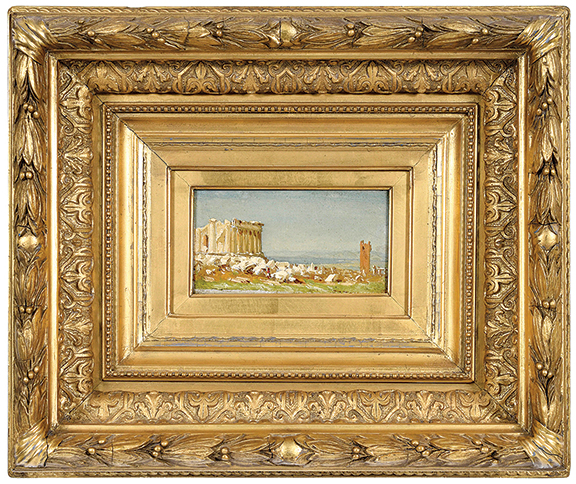
Study for the Ruins of the Parthenon by Sanford Robinson Gifford (1823-1880) is a small 3½” x 6¼” painting in a large 14″ x 16½” frame. An on-site bidder paid $46,740 (est. $30,000/50,000) for the Gifford study.• A large carved gilt frame dwarfed the 3½” x 6¼” Study for the Ruins of the Parthenon by Sanford Robinson Gifford (1823-1880). The painting on artist’s board came from the Finn collection. The 27 3/8″ x 52¼” full-scale version of Ruins of the Parthenon hangs in the National Gallery of Art in Washington, D.C. The study sold to an on-site bidder for $46,740. When asked his name, the bidder declined but said he bought the painting for a client that was later revealed as “an institution.”
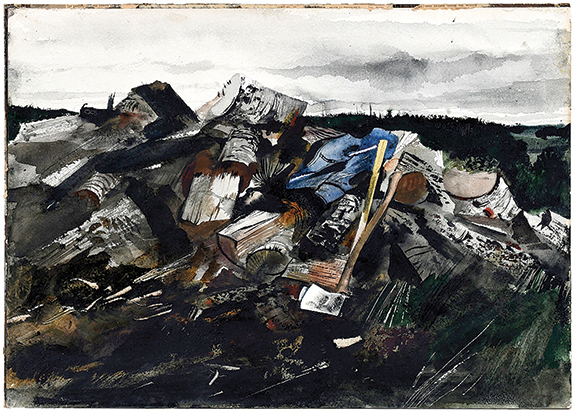
Andrew Wyeth (1917-2009) painted his iconic Christina’s World in 1948. This signed watercolor on paper, Birchwood, was painted contemporaneously with that painting. The 14″ x 20″ (sight size) Birchwood sold to an absentee bidder for $44,280 (est. $35,000/45,000).• Birchwood by Andrew Wyeth (1917-2009), a 1948 watercolor on paper, depicting a freshly created woodpile and the ax that did the chopping, sold within estimate at $44,280 to a private collector from Connecticut bidding absentee.
• Sunset by William Sonntag (1822-1900), an oil on canvas that hung over the mantel in the Finns’ great room in Litchfield, Connecticut, sold above estimate at $39,360 to a New York dealer on the phone.
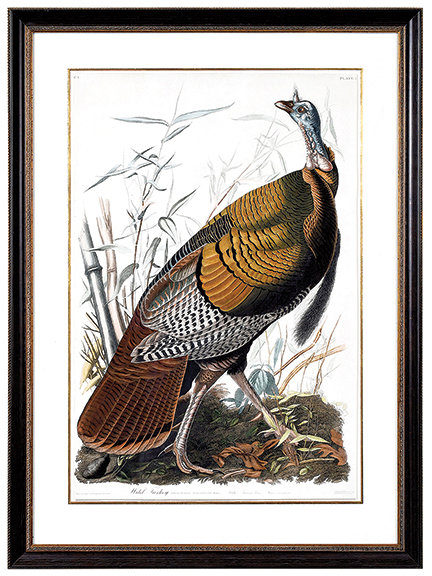
John James Audubon (1785-1851) put a price of $1000 on each of the nearly 200 complete folios of the Havell edition of The Birds of America. Wild Turkey, Plate 1, comes from one of those folios. The 38 3/16″ x 25¼” (sight size) hand-colored engraving with etching and aquatint on paper sold to an absentee bidder for $46,740 (est. $40,000/60,000).“The real news of the sale,” said Zander after the sale, “was that the painting market did well for us.” Traditional paintings that some may regard as out of fashion, said Zander, found a strong buying base.
Included in the sale were four plates from the 1827-38 Havell edition of The Birds of America by John James Audubon (1785-1851). The star was Plate 1, the much-admired Wild Turkey. This pristine example sold for $46,740 (est. $40,000/60,000) to an absentee bidder. That bidder also purchased Plate XXXVI, Stanley Hawk, for $1845 (est. $30,000/50,000) and Plate 17, Carolina Pigeon, or Turtle Dove for $4920 (est. $20,000/30,000).
The top furniture lots included two of the earliest pieces in the sale. A carved walnut with white pine chest in two sections, attributed to the Boston shop of Mason-Messenger, circa 1680, was crafted during what has been called the Pilgrim century (1620-1720). With five paneled, dovetailed, and side-hung doors, the great chest sold to the phones for $86,100 (est. $30,000/50,000). A 1735-50 Charleston, South Carolina, mahogany dressing table with an unusual drawer arrangement—three dovetailed drawers set with large batwing brasses—sold early in the day to a phone bidder for $49,200 (est. $20,000/30,000).
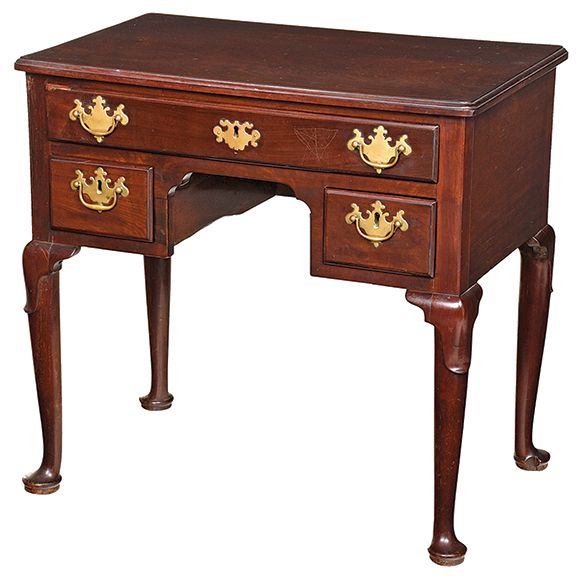
The excellent condition of this 29″ x 30″ x 19″ figured mahogany dressing table was reflected in its sale price of $49,200 (est. $20,000/30,000).
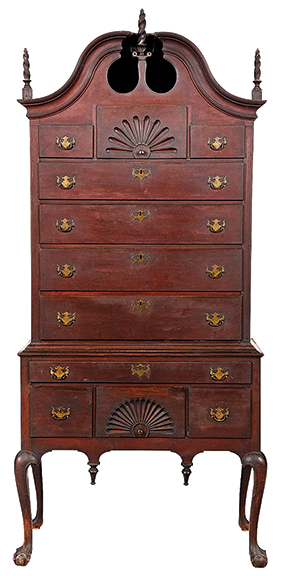
Joel and Ann Finn acquired this Chippendale bonnet-top high chest in the 1980s from Avis Hicock. She lived on Main Street in Woodbury, Connecticut, in the home that was originally owned by her great-grandfather David J. Stiles. The 94″ x 43″ x 22″ two-section chest sold to the phones for $46,740 (est. $40,000/60,000).The top furniture lot from the Finn collection was a 1770-80 Woodbury, Connecticut, Chippendale bonnet-top high chest with an attractive dry surface. The 94″ tall chest had descended in the Stiles family of Woodbury and was included in Making Furniture in Preindustrial America: The Social Economy of Newtown and Woodbury, Connecticut by Edward S. Cooke Jr. (1996). It sold to the phones for $46,740 (est. $40,000/60,000). A nearly identical chest from the Finn collection that had also descended in the Stiles family was passed when it reached only $17,000 on a $20,000/30,000 estimate.
The Finns collected Connecticut-made Chippendale furniture. A Woodbury chest with a closed bonnet, a shell-carved central drawer above five graduated drawers, and a deep shell-carved lower drawer sold to the phones for $27,060 (est. $15,000/25,000). The Finn furniture, much of it handmade between 1780 and 1830 by Connecticut cabinetmakers, came to the sale from Bluffton, South Carolina. Ann Finn, known professionally as Ann Y. Smith, moved south after a 2018 exhibition of the Finn collection at Jeffrey Tillou Antiques in Litchfield, Connecticut.
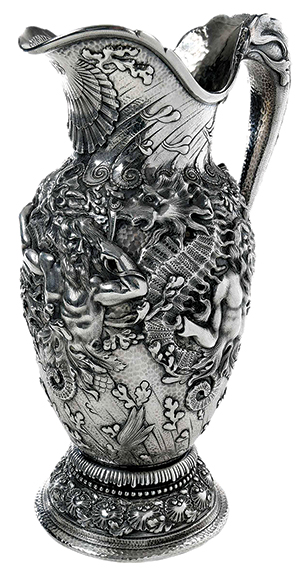
The top silver lot was this Tiffany sterling pitcher with Triton, Poseidon, and giant sea horses on the body and a sea creature for a handle. The 13½” tall pitcher sold on the Invaluable bidding platform for $28,160 (est. $10,000/15,000).The sale was not limited to American paintings, American furniture, and Delft tiles. Two exceptional lots from other categories call out for attention, a pitcher and a shotgun. Triton and his father, sea god Poseidon, stand tall among giant sea horses in a rough sea on the Tiffany sterling pitcher. A scaled sea creature serves as the handle on this stunning piece that sold on the Invaluable bidding platform for $28,160 (est. $10,000/15,000).
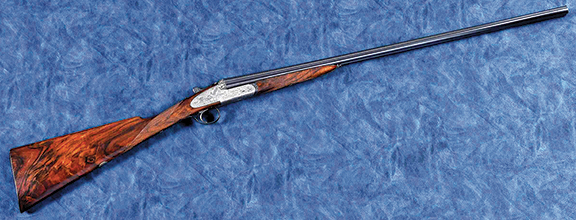
“This gun sold itself when it walked in the door,” said Brunk Auctions’ firearms specialist Corey Jones. During the sale of this circa 1984 Boss & Company double-barrel shotgun, Jones was answering questions from staffers while phone bidders were on the line. The 44″ long gun with a fitted leather case (not shown) sold to a phone bidder for $116,850 (est. $60,000/80,000).Established in 1812, Boss & Company is London’s oldest gun maker. For over 200 years, the motto of the shop, where guns are made by hand using traditional methods, has been “Best Guns Only.” One of the company’s best double-barrel shotguns from 1984, with extensive engraving on the sidelocks, receiver bottom plate, barrel fences, and barrel tang, sold to a phone bidder for $116,850 (est. $60,000/80,000), the third-highest sale of the day.
There were two well-publicized toys in the sale. The J. & E. Stevens Co. Girl Skipping Rope mechanical bank with significant paint losses and some retouch was passed at $16,000 on a $20,000/30,000 estimate. The same fate befell a Little Miami Railroad Company tin toy train set. It reached $6500 on a $10,000/15,000 estimate before being withdrawn.
For more information, visit the website (www.brunkauctions.com) or call (828) 254-6846.
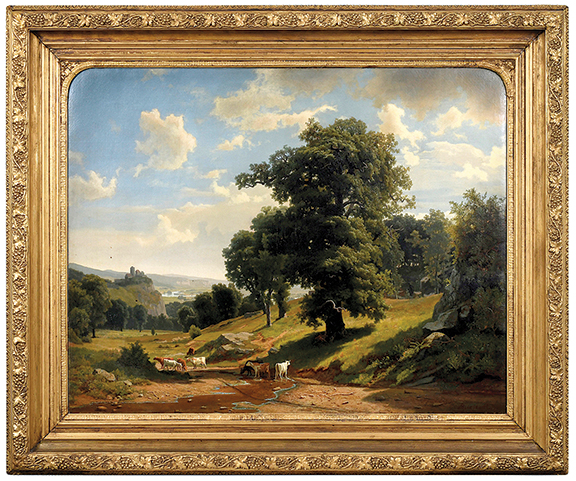
A Quiet Valley by Albert Bierstadt (1830-1902) was one of only three lots to bring over $100,000. The 34″ x 43″ (sight size) oil on canvas from 1855 sold to the phones for $159,900 (est. $70,000/90,000).
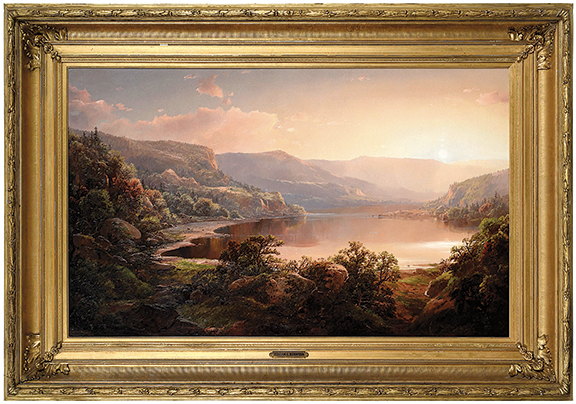
Sunset by William Sonntag (1822-1900), a 32″ x 50″ (sight size) oil on canvas, sold to a New York dealer on the phone for $39,360 (est. $15,000/20,000).
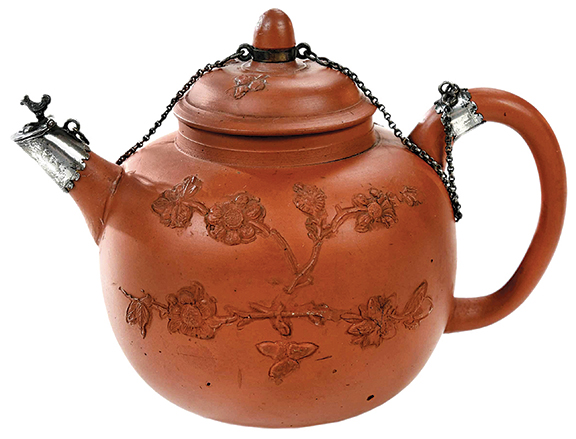
Constance and Dudley Godfrey’s exquisite taste was evident in this Elers brothers silver-mounted unglazed redware teapot. The top is decorated with three applied acorn sprigs and the body with applied flowering prunus branches. The 5″ x 6¾” pot, made in Staffordshire circa 1695, sold to a phone bidder for $19,680 (est. $10,000/12,000).
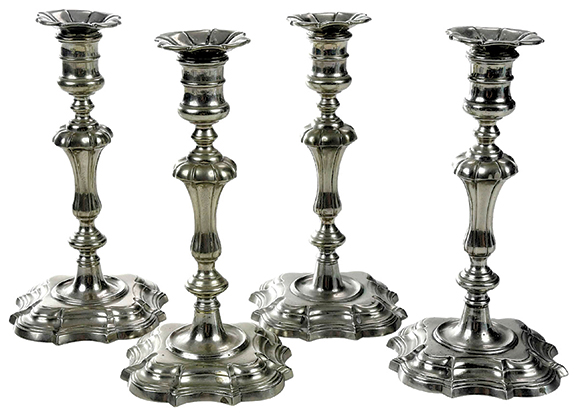
“It is rare to find a set of four candlesticks,” said Andrew Brunk of these mid-18th-century English candlesticks from the Ann and Joel Finn collection. The 9″x 4 5/8″ x 4 5/8″ quartet is made of paktong, an alloy of copper, nickel, and zinc invented by the Chinese. The candlesticks sold to the phones for $3198 (est. $2000/3000).
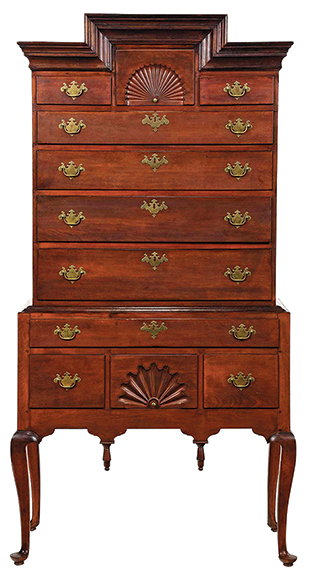
This 80″ x 41½” x 21″ Queen Anne highboy is attributed to Woodbury, Connecticut, cabinetmakers, 1760-80. It had descended in the Sherman family of Woodbury and is notable for its stepped cornice, a regional characteristic. The chest sold to the phones for $10,455 (est. $12,000/18,000).
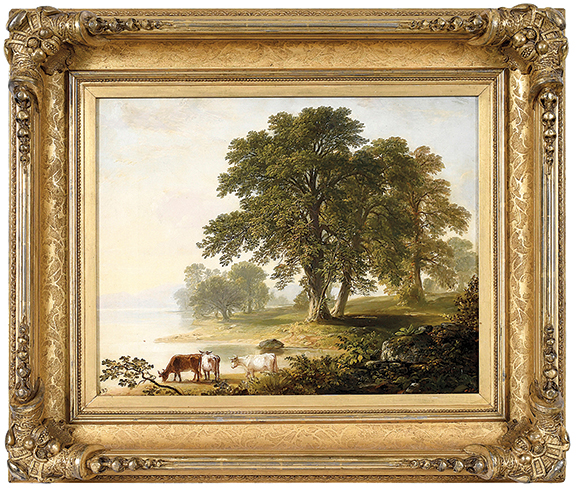
Asher Durand (1796-1886) completed Study for a Summer Afternoon circa 1865. The 16½” x 21″ (sight size) oil on canvas sold to the phones for $56,580 (est. $20,000/30,000). Earlier in his career, Durand engraved portraits for bank notes that were later used for America’s first postage stamps.
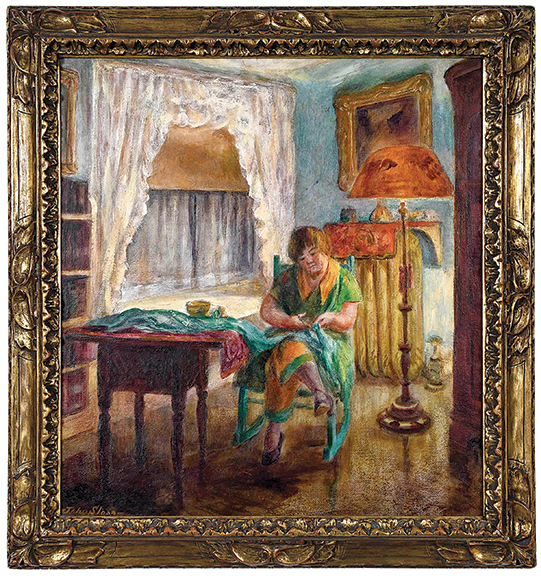
Bidding from the floor, dealer Helen Carlisle of Asheville, North Carolina, and Auburn, Alabama, paid $19,680 for Corner of the Living Room – the Artist’s Wife, 1929, by John Sloan (1871-1951). The 26″ x 24″ (sight size) oil and tempera on masonite was estimated at $18,000/22,000. Carlisle also bought Sightseers (not shown), a 1947 work by Helen Farr Sloan, the artist who married the widowed John Sloan, age 74, in 1945. John Sloan’s first wife, Dolly, is the woman in the 1929 painting. Carlisle paid $2952 for the 16″ x 12″ Sightseers (est. $2500/3500).